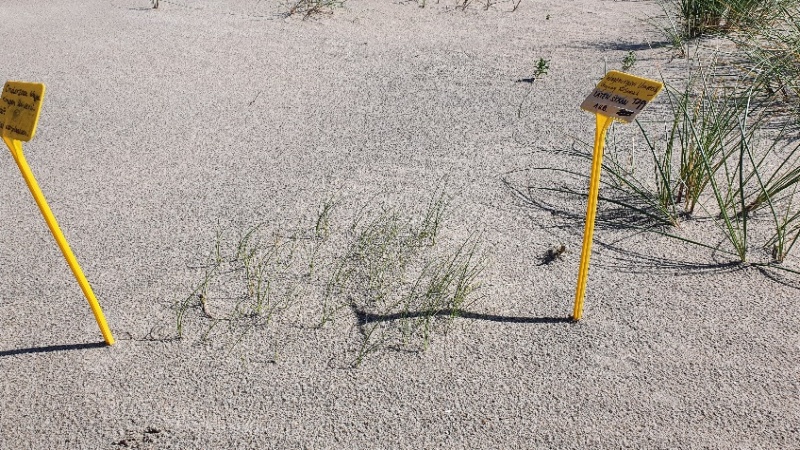S.J. van Rosmalen1*, J-M. Homberger1, M.J.P.M. Riksen1, J. Limpens1
1 Wageningen University and Research
*corresponding author:
Introduction
Sandy shores serve a multitude of purposes: they protect the inland from flooding, support a high biodiversity, and are recreation hotspots (Everard, Jones, and Watts 2010). To what extent these functions can coexist or are mutually exclusive is unclear, especially given increasing stressors such as rising sea levels and urbanization. Knowledge about the trade-offs between these functions is important to ensure optimalization of the desired purpose when designing nature-based solutions at sandy shores. One such potential trade-off is between recreation and nature development. Therefore we investigated the effect of recreational pressure on the establishment of the two common dune building species Marram grass (Ammophila arenaria) and Sand couch grass (Elytrigia juncea).
Methods
We conducted a field introduction experiment with seeds and rhizomes of both species along increasing distance to beach entrances. We used a randomised block design with 4 factorial treatments (species * type diaspore) and 60 replicates for two beaches on the Dutch barrier island of Terschelling. Plant material was collected from the wild, using local genetic material. The plant seeds were left in their husk to mimic natural dispersal. To enable undisturbed recreation, the plots were left unmarked and georeferenced by means of Real Time Kinematic positioning. Recreation pressure was assessed by counting visitations to different beach sections, confirming that anthropogenic pressure decreased with distance from the beach entrance. Establishment success was monitored by counting the number of emerged seeds and sprouted rhizomes per plot across the growing season. To control for other drivers, we also monitored environmental variables, such as the change in beach level.
Results
Preliminary results suggest that environmental factors such as erosion and burial limit the establishment success for both dune building species. Moreover, a positive effect of distance from the entrance on the establishment success of both species can be observed. This is especially clear within the first 100 meters. The strongest effect seems to be for Marram grass. These preliminary results indicate that both sediment dynamics and recreational pressure play a role in the successful establishment of these species on the upper beach. This trade-off between recreation and nature development should be considered when designing sandy coastal areas.

Figure 1: Example of a plot with emerged seedlings.
References
Everard, Mark, Laurence Jones, and Bill Watts. 2010. "Have We Neglected the Societal Importance of Sand Dunes? An Ecosystem Services Perspective." Aquatic Conservation: Marine and Freshwater Ecosystems 20 (4): 476–87. https://doi.org/10.1002/aqc.1114.
I. Surname1*, F.N. Another-Surname2 , Y. Next-Surname2
1 University Name, Country; 2 Organization Name, Country
* Corresponding author: mail.name@organization.org


